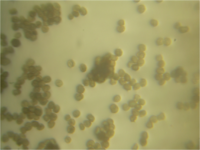
Expression of alternative NADH dehydrogenases (NDH‐2) in the phytopathogenic fungus Ustilago maydis
Sign Up to like & getrecommendations! Published in 2018 at "FEBS Open Bio"
DOI: 10.1002/2211-5463.12475
Abstract: Type 2 alternative NADH dehydrogenases (NDH‐2) participate indirectly in the generation of the electrochemical proton gradient by transferring electrons from NADH and NADPH into the ubiquinone pool. Due to their structural simplicity, alternative NADH dehydrogenases… read more here.
Keywords: ustilago maydis; dehydrogenases ndh; alternative nadh; nadh dehydrogenases ... See more keywords

Identification of a novel member of the pH responsive pathway Pal/Rim in Ustilago maydis
Sign Up to like & getrecommendations! Published in 2019 at "Journal of Basic Microbiology"
DOI: 10.1002/jobm.201800180
Abstract: The most important signal transduction mechanism related to environmental pH responses in fungi is the Pal/Rim pathway. Our knowledge of this pathway came initially from studies on Ascomycota species where it is made by seven… read more here.
Keywords: ustilago maydis; pal rim; novel member; pathway ... See more keywords

The UMAG_00031 gene from Ustilago maydis encodes a putative membrane protein involved in pH control and morphogenesis
Sign Up to like & getrecommendations! Published in 2020 at "Archives of Microbiology"
DOI: 10.1007/s00203-020-01936-6
Abstract: We report the characterization of the gene UMAG_00031 from Ustilago maydis, previously identified as upregulated at alkaline pH. This gene is located on chromosome 1 and contains an ORF of 1539 bp that encodes a… read more here.
Keywords: encodes putative; ustilago maydis; 00031 gene; gene ... See more keywords

Chemical Constituents and Bioactive Principles from the Mexican Truffle and Fermented Products of the Derived Fungus Ustilago maydis MZ496986.
Sign Up to like & getrecommendations! Published in 2023 at "Journal of agricultural and food chemistry"
DOI: 10.1021/acs.jafc.2c08149
Abstract: To look in-depth into the traditional Mexican truffle, this study investigated the phytochemical and pharmacological properties of field-collected corn galls and the fermentate of its pathogen Ustilago maydis MZ496986. Here, we established the chemical profiles… read more here.
Keywords: maydis mz496986; chemical; ustilago maydis; mexican truffle ... See more keywords

Ustilago maydis effectors and their impact on virulence
Sign Up to like & getrecommendations! Published in 2017 at "Nature Reviews Microbiology"
DOI: 10.1038/nrmicro.2017.33
Abstract: Biotrophic fungal plant pathogens establish an intimate relationship with their host to support the infection process. Central to this strategy is the secretion of a range of protein effectors that enable the pathogen to evade… read more here.
Keywords: ustilago maydis; impact virulence; maydis effectors; host ... See more keywords

Neofunctionalization of the secreted Tin2 effector in the fungal pathogen Ustilago maydis
Sign Up to like & getrecommendations! Published in 2018 at "Nature Microbiology"
DOI: 10.1038/s41564-018-0304-6
Abstract: Plant-pathogenic fungi hijack their hosts by secreting effector proteins. Effectors serve to suppress plant immune responses and modulate the host metabolism to benefit the pathogen. Smut fungi are biotrophic pathogens that also parasitize important cereals,… read more here.
Keywords: pathogen; secreted tin2; ustilago maydis; tin2 effector ... See more keywords

The Ustilago maydis null mutant strains of the RNA-binding protein UmRrm75 accumulate hydrogen peroxide and melanin
Sign Up to like & getrecommendations! Published in 2019 at "Scientific Reports"
DOI: 10.1038/s41598-019-47133-4
Abstract: Ustilago maydis is a dimorphic fungus that has emerged as a model organism for the study of fungal phytopathogenicity and RNA biology. In a previous study, we isolated the U. maydis UmRrm75 gene. The deletion… read more here.
Keywords: ustilago maydis; melanin; umrrm75 mutant; mutant strains ... See more keywords

Ustilago maydis, the corn smut fungus, has an unusual diploid mitotic stage
Sign Up to like & getrecommendations! Published in 2017 at "Mycologia"
DOI: 10.1080/00275514.2016.1274597
Abstract: ABSTRACT Ustilago maydis causes common smut disease in maize. Although pathogenic diploid strains of the fungus have been known for many years, the normal life cycle was thought to involve an extended dikaryotic stage, with… read more here.
Keywords: maydis; ustilago maydis; diploid mitotic; mitotic stage ... See more keywords

Combination of in-vivo proximity labeling and co-immunoprecipitation identifies the host target network of a tumor-inducing effector in the fungal maize pathogen Ustilago maydis.
Sign Up to like & getrecommendations! Published in 2023 at "Journal of experimental botany"
DOI: 10.1093/jxb/erad188
Abstract: Plant pathogens secrete effectors, which target host proteins to facilitate infection. The Ustilago maydis effector UmSee1 is required for tumor formation in the leaf during infection of maize. UmSee1 interacts with maize SGT1 and blocks… read more here.
Keywords: maydis; ustilago maydis; proximity; combination ... See more keywords

Natural antisense transcripts are linked to the modulation of mitochondrial function and teliospore dormancy in Ustilago maydis
Sign Up to like & getrecommendations! Published in 2017 at "Molecular Microbiology"
DOI: 10.1111/mmi.13587
Abstract: The basidiomycete smut fungus Ustilago maydis causes common smut of corn. This disease is spread through the production of teliospores, which are thick‐walled dormant structures characterized by low rates of respiration and metabolism. Teliospores are… read more here.
Keywords: ssm1; ustilago maydis; dormancy; mitochondrial function ... See more keywords

Progress in pathogenesis research of Ustilago maydis, and the metabolites involved along with their biosynthesis
Sign Up to like & getrecommendations! Published in 2023 at "Molecular Plant Pathology"
DOI: 10.1111/mpp.13307
Abstract: Abstract Ustilago maydis is a pathogenic fungus that causes corn smut. Because of its easy cultivation and genetic transformation, U. maydis has become an important model organism for plant‐pathogenic basidiomycetes. U. maydis is able to… read more here.
Keywords: ustilago maydis; biosynthesis; metabolites involved; maydis metabolites ... See more keywords